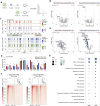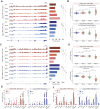Increased transcriptional elongation and RNA stability of GPCR ligand binding genes unveiled via RNA polymerase II degradation
- PMID: 38842922
- PMCID: PMC11317166
- DOI: 10.1093/nar/gkae478
Increased transcriptional elongation and RNA stability of GPCR ligand binding genes unveiled via RNA polymerase II degradation
Abstract
RNA polymerase II drives mRNA gene expression, yet our understanding of Pol II degradation is limited. Using auxin-inducible degron, we degraded Pol II's RPB1 subunit, resulting in global repression. Surprisingly, certain genes exhibited increased RNA levels post-degradation. These genes are associated with GPCR ligand binding and are characterized by being less paused and comprising polycomb-bound short genes. RPB1 degradation globally increased KDM6B binding, which was insufficient to explain specific gene activation. In contrast, RPB2 degradation repressed nearly all genes, accompanied by decreased H3K9me3 and SUV39H1 occupancy. We observed a specific increase in serine 2 phosphorylated Pol II and RNA stability for RPB1 degradation-upregulated genes. Additionally, α-amanitin or UV treatment resulted in RPB1 degradation and global gene repression, unveiling subsets of upregulated genes. Our findings highlight the activated transcription elongation and increased RNA stability of signaling genes as potential mechanisms for mammalian cells to counter RPB1 degradation during stress.
© The Author(s) 2024. Published by Oxford University Press on behalf of Nucleic Acids Research.
Figures








Similar articles
-
IWS1 positions downstream DNA to globally stimulate Pol II elongation.Nat Commun. 2025 Aug 20;16(1):7747. doi: 10.1038/s41467-025-62913-5. Nat Commun. 2025. PMID: 40835814 Free PMC article.
-
High-dose estrogen impairs demethylation of H3K27me3 by decreasing Kdm6b expression during ovarian hyperstimulation in mice.J Zhejiang Univ Sci B. 2025 Mar 13;26(3):269-285. doi: 10.1631/jzus.B2300681. J Zhejiang Univ Sci B. 2025. PMID: 40082205 Free PMC article.
-
Cell-cycle-regulated transcriptional pausing of Drosophila replication-dependent histone genes.Mol Biol Cell. 2025 Jul 1;36(7):ar88. doi: 10.1091/mbc.E25-05-0212. Epub 2025 May 21. Mol Biol Cell. 2025. PMID: 40397569
-
Antidepressants for pain management in adults with chronic pain: a network meta-analysis.Health Technol Assess. 2024 Oct;28(62):1-155. doi: 10.3310/MKRT2948. Health Technol Assess. 2024. PMID: 39367772 Free PMC article.
-
Interventions for promoting habitual exercise in people living with and beyond cancer.Cochrane Database Syst Rev. 2018 Sep 19;9(9):CD010192. doi: 10.1002/14651858.CD010192.pub3. Cochrane Database Syst Rev. 2018. PMID: 30229557 Free PMC article.
References
-
- Chen X., Xu Y.. Structural insights into assembly of transcription preinitiation complex. Curr. Opin. Struct. Biol. 2022; 75:102404. - PubMed
-
- Girbig M., Misiaszek A.D., Müller C.W.. Structural insights into nuclear transcription by eukaryotic DNA-dependent RNA polymerases. Nature reviews. Nat. Rev. Mol. Cell Biol. 2022; 23:603–622. - PubMed
-
- Werner F., Grohmann D.. Evolution of multisubunit RNA polymerases in the three domains of life. Nat. Rev. Microbiol. 2011; 9:85–98. - PubMed
MeSH terms
Substances
Grants and funding
LinkOut - more resources
Full Text Sources

